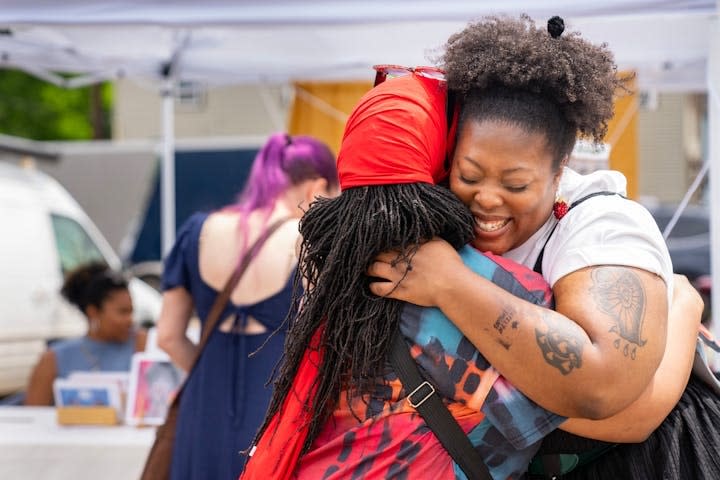Minneapolis residents celebrate Juneteenth with annual 'Soul of the Southside' festival

Four years ago, this south Minneapolis neighborhood was the charred epicenter of Minnesota's racial reckoning. On Wednesday, residents gathered there to celebrate the legacy of Juneteenth and Black liberation.
Thousands convened at Lake Street and Minnehaha Avenue for the annual Soul of the Southside Juneteenth Festival. The mission of the event is to showcase the talents of Black creatives, business owners and community organizations, and to represent the neighborhood's ongoing efforts to create lasting change.
"I absolutely love the South Side," said Antoinette Mitchell, who was selling her customized water bottles at the festival. "There is a lot of love here and the community is great."
Festival-goers danced to music from local DJs, perused the work of local artists and enjoyed food from trucks and booths.
Juneteenth, a portmanteau of June 19, commemorates the date in 1865 that enslaved Black people in Texas were told — a full two years after the signing of the Emancipation Proclamation — that they were no longer slaves.
Juneteenth became a state holiday last year and serves as a reminder of America's history of slavery and systemic racism.
The rain gave way Wednesday afternoon, bringing sunny skies to the Minneapolis festival. One of the festival's anchor locations was the Coliseum building on East Lake Street, heavily damaged in the riots following the police murder of George Floyd in 2020.
Juneteenth served as the building's reopening after $28 million in repairs. It now hosts exhibits, including "Black Renaissance in Real Time," which showcased the work of local Black artists.
The festival attracted community organizations seeking to shed light on the issues facing Minnesota's Black community.
Duaba Unenra ran a booth for the Open Road Fund. The program operates in Minnesota and the Dakotas and distributes $50,000 grants to Black families descended from people enslaved in the Americas to improve their financial wellbeing, economic power, education, housing and health.
"This program is not a reparations program," Unenra said. "$50,000 is not enough money to account for the damages that have been done to our people — enslavement, Jim Crow and the new Jim Crow. However, this is a program that is stewarded by the Black community and is meant to help us to heal from generations of economic inequality."
Behind every booth was a different story.
This was Mitchell's first year at the festival. She started Splash of Royalty Designs after becoming the full-time caretaker for her ailing mother and needing an artistic outlet.
Next to Jasmine D'Avilar's handmade crocheted clothing sat a table of work by local artists up for auction to raise money for D'Avilar's mom, who is recovering from breast cancer.
Alexis Wall, a mixed media artist who also has a piece on display at the Black Renaissance exhibit in the Coliseum building, sold prints of her work.
"I want people to feel a reflection of themselves in my work," Wall said. "It is really important to me to show the emotion and resilience of communities of color."

